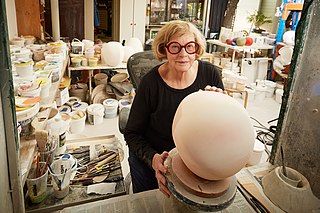Related Research Articles

Shōji Hamada was a Japanese potter. He had a significant influence on studio pottery of the twentieth century, and a major figure of the mingei (folk-art) movement, establishing the town of Mashiko as a world-renowned pottery centre. In 1955 he was designated a "Living National Treasure".

Dame Lucie Rie, was an Austrian-born, independent, British studio potter working in a time when most ceramicists were male. She is known for her extensive technical knowledge, her meticulously detailed experimentation with glazes and with firing and her unusual decorative techniques.

Doris More Lusk was a New Zealand painter, potter, art teacher, and university lecturer. In 1990 she was posthumously awarded the Governor General Art Award in recognition of her artistic career and contributions.
Jane Dodd is a New Zealand musician and contemporary jeweller. She is well known for her role as a bass player in early Dunedin-based Flying Nun Records groups The Chills and The Verlaines, was a long-standing member of Auckland group Able Tasmans, and occasionally played with side-project The Lure of Shoes.
Ian Barry Brickell was a New Zealand potter, writer, conservationist and founder of Driving Creek Railway.
Noeline Brokenshire was a New Zealand sportswoman, who represented her country in field hockey, and as a hurdler at the 1950 British Empire Games. Later she was a gallery owner and noted woodturner, and the founder and publisher of New Zealand's first woodworking magazine, Touch Wood.

John Paul Miller was an American jewellery designer and goldsmith, who also produced films, photographs and paintings. Stephen Harrison, decorative arts curator at the Cleveland Museum of Art, compares Miller's work with that of René Lalique and Louis Comfort Tiffany.

Jens Høyer Hansen was a Danish-born jeweller who settled in New Zealand and did most of his well-known work in Nelson, New Zealand. Hansen was one of a number of European-trained jewellers who came to New Zealand in the 1960s and transformed contemporary jewellery in the country, including Tanya Ashken, Kobi Bosshard and Gunter Taemmler.
Joyce Scott FRSASA 'is an Australian artist working in drawing, oil painting and ceramics.' 'She has held ten independent exhibitions, is represented internationally and has received five awards.' 'Scott, née Mottershead, was born in Poynton, Cheshire, England in 1938 and migrated with her family to Adelaide, South Australia in 1951.'
Kobi Bosshard is a Swiss-born New Zealand jeweller. Bosshard was one of a number of European-trained jewellers who came to New Zealand in the 1960s and transformed contemporary jewellery in the country; others include Jens Hoyer Hansen, Tanya Ashken and Gunter Taemmler.
Bronwynne Cornish is a New Zealand ceramicist, sculptor and arts educator.
Peter Alger is a New Zealand potter.

Lisa Walker is a contemporary New Zealand jeweller.
Richard John Parker is a New Zealand potter who has been based in Kaeo for most of his career.

Richard Steward Rudd is an English-born New Zealand potter.
Areta Rachael Wilkinson is a New Zealand jeweller.

John Parker Glick was an American ceramicist. Though open to artistic experimentation, Glick was most influenced by the styles and aesthetics of Asian pottery—an inspiration that shows in his use of decorative patterns and glaze choices. His experience working with ceramics led him to publish several articles about the craft. In addition to producing pottery, Glick began making "landscape oriented" wall panels during the latter part of his career. Known as "the people's potter," he is primarily remembered for his contributions to art and the field of ceramics.
Eléna Gee is a New Zealand jeweller known for her combination of metal work with organic materials, specifically pāua shell. She was a prominent figure in the Bone, Stone, Shell movement in 1980s New Zealand. She has had a long career with her work touring around Asia and Europe.

Pippin Drysdale is an Australian ceramic artist and art teacher. She is regarded as the foremost interpreter of the Australian landscape in the field of ceramics. Her works are known for their intensity of colour and linear markings that interpret the artist's relationship with the Australian landscape. She was recognized as one of Western Australia’s State Living Treasures in 2015. She is Australia's highest earning ceramicist.

Neil Macalister Grant was a New Zealand potter and ceramics teacher.
References
- ↑ "Artform-Nelson captured in Clay Contemporary Craft and Jewellery". Artform. Archived from the original on 24 June 2021. Retrieved 19 June 2021.
- ↑ "Chance led this Nelson couple to their dream home". Stuff. 3 February 2019. Archived from the original on 24 June 2021. Retrieved 19 June 2021.
- 1 2 3 4 Malcolm, Nancy (1997). "Katie Gold". New Zealand Potter . 39 (2): 32.
- 1 2 3 Jeanette Cook (2005). Crafted by Design: Inside New Zealand craft artists' studios. Illustrator: Stephen Robinson. Auckland: Godwit Press. ISBN 1-86962-116-6. OL 8649405M. Wikidata Q107291760.
- ↑ "Artform-Nelson captured in Clay Contemporary Craft and Jewellery". Artform. Retrieved 7 January 2022.
- ↑ "Art seen: June 29". Otago Daily Times Online News. 29 June 2023. Retrieved 6 July 2024.